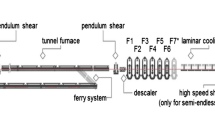Abstract
Internal subsurface cracks in continuously cast slabs can lead to catastrophic failure of the material when it is subjected to further rolling or shaping. The interplay of multiple factors contributes to the formation of these cracks, making it occasionally challenging to accurately assess slab quality based solely on surface appearance. This paper presents an in-depth exploration of the internal quality of slabs, that aimed to identify the critical parameters responsible for initiating and propagating these cracks. The investigation employs a range of methodologies, including macro- and micro-metallographic analysis, thermo-mechanical simulations, that aid in characterizing defects and understanding material vulnerability. To prevent such failures in cast products, the study also proposes optimized operational parameters.











Similar content being viewed by others
References
J.K. Brimacombe, K. Sorimachi, Crack formation in the continuous casting of steel. Metall. Trans. B. 8, 489–505 (1977)
Z. Franìk, M. Masarik, J. Smíd, Determination of the cause of the formation of transverse internal cracks on a continuously cast slab. Mater. Technol. 49(2), 285–290 (2015). https://doi.org/10.17222/mit.2013.224
J.Y. Jeong, B.T. Kim, S.H. Kwon, M.H. Kang, D.G. Kim, Y.U. Heo, C.H. Yim, Effect of interdendritic impurity segregation on hot ductility behavior of low-carbon steels. Steel Res. Int. 91(11), 2000046 (2020). https://doi.org/10.1002/srin.202000046
M. Varadarajan, L.N. Bartlett, R.J.O’ Malley, S.N. Lekakh, The influence of Ti, Nb and V on the hot ductility of as-cast microalloyed steels AISTech 2020—Proceedings of the Iron and Steel Technology Conference, pp. 1470–1478
K. Miłkowska-Piszczek, M. Dziarmagowski, A. Buczek, J. Pióro, The methods of calculating the solidifying strand shell thickness in a continuous casting machine. Arch. Mater. Sci. Eng. 57(2), 75–79 (2012)
M. Gontijo, C. Hoflehner, P. Estermann, S. Ilie, J. Six, C. Sommitsch, Effect of strain rate on the hot ductility behavior of a continuously cast Ti–Nb microalloyed steel. Steel Res. Int. Res. Int. 91(12), 2000222 (2020). https://doi.org/10.1002/srin.202000222
Author information
Authors and Affiliations
Corresponding author
Additional information
Publisher's Note
Springer Nature remains neutral with regard to jurisdictional claims in published maps and institutional affiliations.
Rights and permissions
Springer Nature or its licensor (e.g. a society or other partner) holds exclusive rights to this article under a publishing agreement with the author(s) or other rightsholder(s); author self-archiving of the accepted manuscript version of this article is solely governed by the terms of such publishing agreement and applicable law.
About this article
Cite this article
Roy, S., Singh, R.K., Deva, A. et al. Investigation of Genesis of Internal Subsurface Crack in Continuous Cast Slabs and Finding Remedial Measures. J Fail. Anal. and Preven. 23, 2633–2639 (2023). https://doi.org/10.1007/s11668-023-01799-1
Received:
Revised:
Accepted:
Published:
Issue Date:
DOI: https://doi.org/10.1007/s11668-023-01799-1




